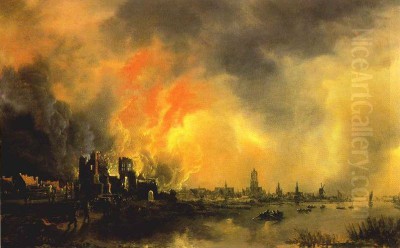
The Dutch Golden Age, spanning roughly the 17th century, witnessed an unprecedented flourishing of arts and sciences in the newly independent Dutch Republic. Among the legions of talented painters who captured the landscapes, portraits, and daily life of this prosperous nation, Aert van der Neer (c. 1603/1604–1677) carved a unique and atmospheric niche. While contemporaries like Rembrandt van Rijn explored the human psyche and others like Johannes Vermeer perfected scenes of tranquil domesticity, Van der Neer dedicated himself almost exclusively to the subtle poetry of light under specific conditions: the ethereal glow of moonlight, the dramatic flicker of firelight, and the crisp, reflective ambiance of winter. Despite his profound skill in rendering these challenging effects, his life was marked by a persistent lack of recognition and financial hardship, creating a poignant contrast between artistic achievement and worldly success.
Early Life and Artistic Beginnings in Gorinchem and Amsterdam
Aert van der Neer, whose first name is sometimes given as Artus or Arthur, was born in Gorinchem (often spelled Gorkum or Gorcum at the time), a town in South Holland. The exact date of his birth remains uncertain, placed either in late 1603 or early 1604. Unlike many Dutch painters who came from artistic families or received formal apprenticeships from a young age, Van der Neer's path to painting was less direct. His early years were spent not in a studio, but in the service of the lords of Arkel, near his hometown, where he held the position of a steward (majoor). This administrative role suggests a practical background, far removed from the bohemian life often associated with artists.
It was likely during his time in Arkel, or shortly thereafter, that his artistic inclinations began to surface, possibly nurtured by interactions with local painters. Crucial to his development were the brothers Rafael Govertsz Camphuysen (1597–1657) and Jochem Govertsz Camphuysen (1601–1659). Sources suggest Van der Neer may have received some informal training from Rafael, who was known for his landscapes. Furthermore, a close personal connection was forged; Aert van der Neer married Lysbeth (or Lysets) Govaertsdr., the sister of the Camphuysen brothers, around 1629. This familial tie undoubtedly facilitated artistic exchange and encouragement.
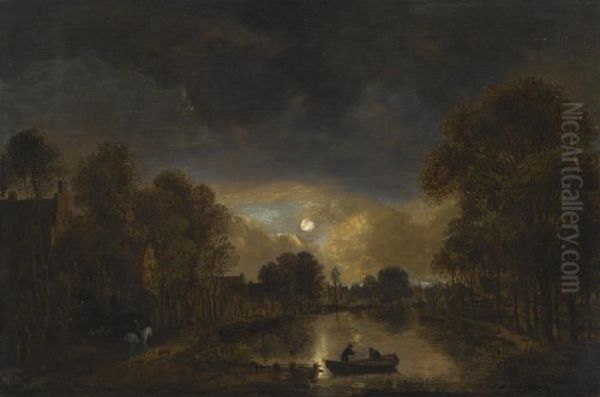
By the early 1630s, Van der Neer had relocated to Amsterdam, the bustling economic and cultural heart of the Dutch Republic. This move signaled a commitment to pursuing painting more seriously. His earliest known dated works emerge from this period, around 1632 or 1633. These initial paintings often show the clear influence of the Camphuysen brothers, particularly Jochem, featuring genre scenes and landscapes rendered in a style that also bore traces of the broader Flemish landscape tradition, perhaps influenced by artists like Gillis van Coninxloo, and the emerging tonal tendencies of the Haarlem school, pioneered by figures such as Esaias van de Velde.
The Emergence of a Distinctive Vision: Tonal Landscapes of Night and Winter
While his early works aligned with prevailing trends, Aert van der Neer soon began to cultivate a highly personal and specialized artistic identity. He became a key figure, alongside painters like Jan van Goyen (1596–1656) and Salomon van Ruysdael (c. 1602–1670), in developing the "tonal landscape" style. This approach favored atmospheric unity over detailed description, employing a restricted palette of browns, grays, greens, and silvery blues to evoke mood and the subtle effects of light and weather. Unlike Van Goyen or Salomon van Ruysdael, who often depicted expansive river views or dune landscapes under daylight, Van der Neer applied tonal principles primarily to less common subjects: nocturnes and winter scenes.
His fascination with the Dutch landscape under the veil of night became his most defining characteristic. He possessed an extraordinary ability to capture the nuances of moonlight reflecting on water, casting long shadows, and silhouetting windmills, cottages, and trees against a subtly gradated sky. He avoided dramatic chiaroscuro in the manner of Caravaggio or Rembrandt, instead focusing on the gentle diffusion of light and the pervasive quietude of the nocturnal world. His compositions often feature low horizons, allowing the sky and its celestial illumination to dominate the scene, enhancing the sense of tranquility and vastness.
Parallel to his moonlit scenes, Van der Neer developed an equal mastery in depicting winter landscapes. He captured the stark beauty of frozen canals and rivers, snow-covered fields, and the bare branches of trees under pale winter light or the soft glow of twilight. These scenes are often populated with small figures engaged in typical winter activities – skating, sledding, or playing kolf (a precursor to golf) on the ice – adding touches of human life and narrative interest to the otherwise still environment. His winter scenes stand comparison with those of specialists like Hendrick Avercamp (1585–1634), though Van der Neer's approach generally emphasized atmosphere and light effects over the anecdotal detail and brighter colors often found in Avercamp's work.
Master of the Nocturne: Capturing Moonlight and Firelight

Aert van der Neer's reputation rests significantly on his unparalleled skill in painting nocturnes. He produced a large number of these scenes throughout his career, exploring variations on the theme of moonlit rivers and canals. His technique involved meticulous layering of thin glazes to achieve the subtle transitions of tone necessary to depict the low light levels accurately. The moon itself might be hidden behind clouds or partially obscured, its presence felt through the silvery highlights on water ripples, rooftops, and the edges of clouds.
His typical nocturnal compositions often feature a river or canal receding into the distance, flanked by trees, buildings, or windmills. Small boats might be moored along the banks, their forms rendered as dark silhouettes. Figures are usually sparse and small-scale, emphasizing the dominance of nature and the quiet solitude of the night. The reflections on the water's surface are a key element, rendered with remarkable sensitivity to capture the interplay of light, shadow, and gentle movement. Works like Moonlit River Scene (c. 1648) exemplify this mastery, showcasing a village bathed in cool moonlight, with details like distant windmills and foreground figures adding scale and interest without disrupting the overall serene mood.
Beyond moonlight, Van der Neer also tackled the more dramatic effects of firelight. He famously depicted the disastrous fire that consumed Amsterdam's Old Town Hall on the night of July 7, 1652. Several paintings capture this event, showing the intense orange and red glow of the flames illuminating the surrounding buildings and crowds, contrasting sharply with the dark night sky. These works demonstrate his versatility in handling different types of nocturnal light, moving from the cool tranquility of moonlight to the chaotic energy of a conflagration, yet always maintaining a keen observation of light's behavior and atmospheric effect.
Painter of Winter's Realm: Ice, Snow, and Atmosphere
Van der Neer's winter landscapes form the second major pillar of his oeuvre. He approached these scenes with the same sensitivity to light and atmosphere that characterized his nocturnes. He excelled at rendering the specific quality of light in winter – often low, diffuse, and casting long, weak shadows. His snow is not merely white but subtly modulated with blues and grays to convey texture and the effect of ambient light. Frozen water surfaces are depicted with convincing realism, showing reflections, skate marks, and areas of thicker ice or snow cover.
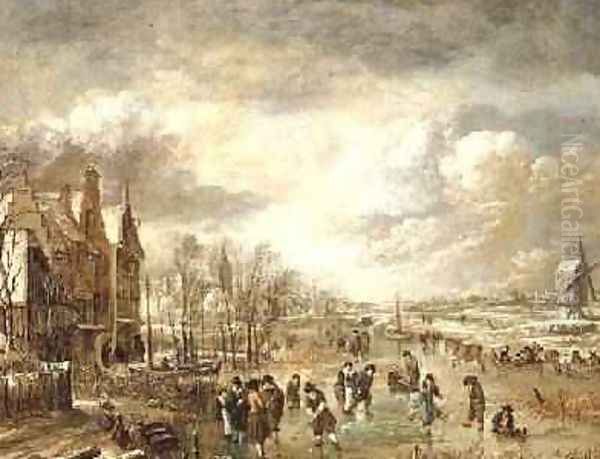
Many of his winter scenes are bustling with activity, providing a glimpse into 17th-century Dutch life during the cold months. Sports on a Frozen River (c. 1648) is a prime example, depicting numerous figures enjoying the ice. Skaters glide gracefully, some play kolf, others converse in small groups, while horse-drawn sleighs traverse the frozen expanse. Despite the activity, the overall mood often remains one of quietude, dictated by the vastness of the landscape and the subdued winter light. The low horizon lines again emphasize the sky, which might be overcast and gray or tinged with the pink and orange hues of sunrise or sunset.
His ability to combine detailed observation of winter conditions with a powerful evocation of mood set his work apart. He captured the crispness of the air, the stillness of the frozen world, and the way light interacts with snow and ice. While other artists, including the aforementioned Hendrick Avercamp and later painters like Jacob van Ruisdael (c. 1628–1682), also depicted winter scenes, Van der Neer's consistent focus on the atmospheric effects of light, often blending winter settings with the low light of dawn, dusk, or even moonlight, gave his interpretations a unique poetic quality.
Representative Works: A Closer Look
Several key paintings encapsulate Aert van der Neer's artistic achievements:
_Moonlit River Scene_ (c. 1648): Often cited as a quintessential example of his nocturnes, this work masterfully balances the cool, silvery light of the moon with the dark silhouettes of the landscape and architecture. The reflections in the water are particularly noteworthy, capturing the gentle ripples and the depth of the night sky. The small figures and distant windmills provide scale and context, grounding the ethereal scene in the Dutch countryside.
_Sports on a Frozen River_ (c. 1648): This painting showcases his skill in depicting winter activities and the specific textures of ice and snow. The composition is lively yet balanced, with numerous figures distributed across the frozen river. The low, diffuse light typical of winter is expertly rendered, contributing to the scene's convincing atmosphere. It highlights his ability to combine genre elements with evocative landscape painting.
_Evening Landscape with a Church Tower_ (date uncertain): This work, or similar compositions focusing on twilight, demonstrates his interest in the transitional moments of the day. The soft, warm light of the setting sun or the cool tones of approaching night create a dreamlike, melancholic atmosphere. The prominent church tower serves as a vertical anchor in the horizontal landscape, a common motif in Dutch landscape painting.
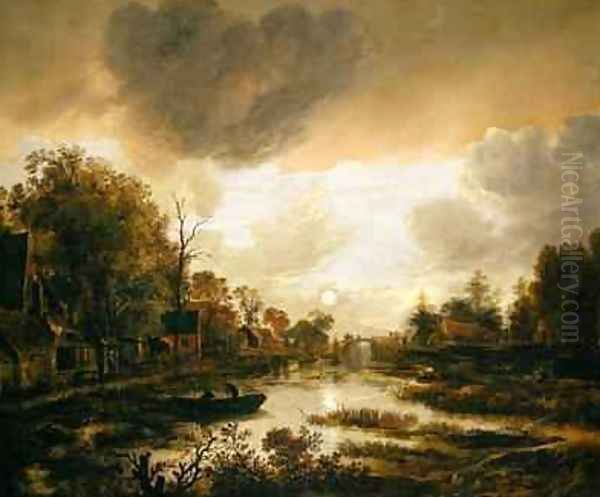
_The Old Town Hall of Amsterdam on Fire_ (1652): This painting, existing in several versions, marks a departure from his typically serene scenes. It captures a specific historical event with dramatic intensity. The contrast between the roaring fire and the dark sky, the reflections on the water, and the illuminated faces of the onlookers showcase his ability to handle complex lighting and a dynamic subject matter.
These examples illustrate the core themes and stylistic features of Van der Neer's art: a profound sensitivity to light and atmosphere, a focus on specific times of day or year (night, winter, twilight), and a preference for riverine or canal landscapes typical of the Netherlands.
Life in Amsterdam: The Struggle for Recognition and Sustenance
Despite his evident talent and the development of a unique artistic voice, Aert van der Neer's life in Amsterdam was far from prosperous. The Dutch art market in the 17th century was highly competitive, flooded with works by numerous skilled painters. While some artists achieved fame and fortune, many struggled to make a living solely from their art. Van der Neer belonged to the latter group.
Historical records and inventories indicate that his paintings commanded very low prices during his lifetime. Some accounts suggest his works sold for as little as five shillings each, a meager sum even by contemporary standards. This lack of commercial success is puzzling given the quality and originality of his work, particularly his nocturnes, which had few rivals. Perhaps his specialization was too niche for mainstream tastes, or maybe he lacked the business acumen or social connections necessary to promote his art effectively in the bustling Amsterdam market.
Faced with persistent financial difficulties, Van der Neer sought alternative sources of income. In 1659, he and his son Johannes took over a wine tavern or inn (wijnhuis) on the Kalverstraat, a major thoroughfare in Amsterdam. The establishment was named "de Graeff van Hollant." This venture into innkeeping, however, proved disastrous. Far from alleviating his financial woes, the business failed, and by December 1662, Aert van der Neer was forced to declare bankruptcy. The inventory taken at the time of his insolvency listed his paintings with disappointingly low valuations, further confirming their lack of market appeal during his life.

He continued to paint in the years following his bankruptcy, but his circumstances did not improve. He lived out his final years in poverty on the Kerkstraat in Amsterdam, where he died in November 1677. He was buried in the Nieuwe Zijds Kapel. His wife, Lysbeth, had predeceased him. Of their six children, only one, Eglon van der Neer (c. 1635/36–1703), followed in his father's footsteps to become a painter. Eglon achieved greater worldly success than Aert, specializing in elegant genre scenes and portraits in the fijnschilder (fine painting) style, a path markedly different from his father's atmospheric landscapes.
Contemporaries and Artistic Milieu
Aert van der Neer operated within a rich and diverse artistic landscape. His primary influences, as noted, were the Camphuysen brothers, who were not only mentors and peers but also family. His move to Amsterdam placed him in the orbit of countless other artists, though direct records of extensive interactions are scarce.
His specialization in landscapes, particularly tonal ones, connects him to Jan van Goyen and Salomon van Ruysdael. While they shared an interest in atmospheric effects and subdued palettes, Van der Neer's focus on night and winter scenes distinguished his output. Jacob van Ruisdael, a slightly younger contemporary, became the most celebrated Dutch landscape painter of the era, known for his more dramatic and often monumental depictions of nature, including powerful winter scenes and seascapes. While both painted winter, Ruisdael's approach often carried a greater sense of nature's sublime power compared to Van der Neer's quieter lyricism.
The snippets mention potential connections or friendships with Albert Cuyp (1620–1691) and Meindert Hobbema (1638–1709). Cuyp, based primarily in Dordrecht (a city Van der Neer also had connections with, possibly through the Camphuysens), became famous for his idyllic landscapes bathed in a warm, golden Italianate light – a stark contrast to Van der Neer's cool nocturnes. Hobbema, a student of Jacob van Ruisdael, specialized in wooded landscapes, often detailed and serene, like his famous Avenue at Middelharnis. While Van der Neer, Cuyp, and Hobbema all depicted the Dutch landscape, their styles and preferred subjects differed significantly. Any friendship or direct influence remains largely speculative, though they certainly shared the same artistic environment and likely knew of each other's work. The mention of photographs in Cuyp's work relating to them seems anachronistic and likely a misinterpretation in the source text; perhaps drawings or documented associations were meant.
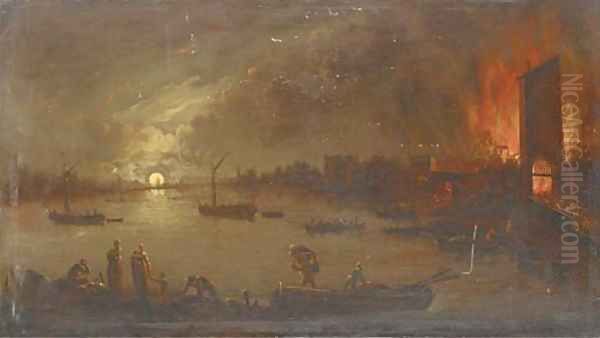
His son, Eglon van der Neer, represents a different facet of the Golden Age, aligning more closely with the Leiden fijnschilders like Gerard Dou or Frans van Mieris the Elder, whose meticulously detailed and highly finished genre scenes were popular with wealthy patrons. This divergence highlights the variety of artistic paths available and the differing fortunes artists could experience.
Later Reputation and Enduring Legacy
During his lifetime and for a considerable period afterward, Aert van der Neer remained a relatively obscure figure. His paintings were undervalued, and his name did not carry the weight of contemporaries like Rembrandt, Vermeer, or Jacob van Ruisdael. However, tastes change, and the 19th century brought a renewed appreciation for his unique talents. The rise of Romanticism, with its emphasis on mood, atmosphere, and the sublime or poetic aspects of nature, created a receptive audience for Van der Neer's evocative nocturnes and winter scenes. Critics and collectors began to recognize the subtle beauty and technical skill inherent in his work.
His sensitive rendering of light effects, particularly moonlight, came to be seen as pioneering. His influence can be traced, albeit sometimes indirectly, in the work of later landscape painters who explored similar themes. The snippets mention Danish painter Jens Juel (1745–1802) and the great German Romantic Caspar David Friedrich (1774–1840), both of whom created atmospheric landscapes, with Friedrich, in particular, mastering scenes imbued with spiritual or emotional resonance, often set at twilight, dawn, or under moonlight. While direct influence is complex to prove, Van der Neer's work provided a precedent for focusing on the emotive power of light and atmosphere in landscape.
In the modern era, his reputation is secure. His paintings are held in major museums worldwide, including the Rijksmuseum in Amsterdam, the National Gallery in London, the Hermitage Museum in St. Petersburg, and the Metropolitan Museum of Art in New York. They are appreciated for their technical mastery, their unique subject matter, and their quiet, poetic beauty. Contemporary artists, such as the Japanese painter Sawako Utsumi mentioned in the source material, continue to find inspiration in his distinctive style, particularly his handling of night and winter light, demonstrating the enduring appeal of his vision. His works now command significant prices on the art market, a stark contrast to the meager sums they fetched during his lifetime.
Conclusion: An Artist of Quiet Light
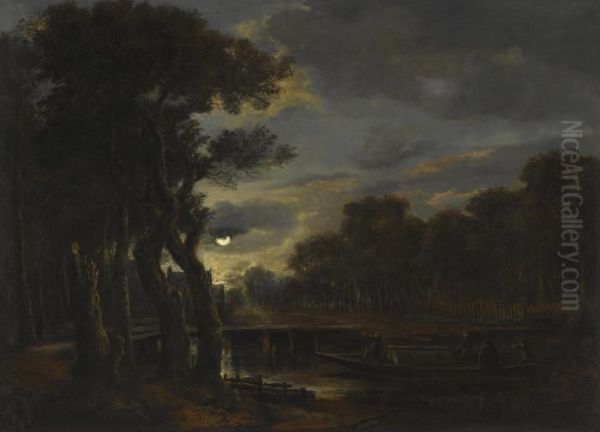
Aert van der Neer stands as a testament to the specialized genius that flourished during the Dutch Golden Age. He chose a narrow path, focusing his considerable talents on capturing the elusive effects of moonlight, firelight, and the specific ambiance of winter. Within this chosen domain, he achieved a level of mastery and sensitivity that was arguably unsurpassed by his contemporaries. His nocturnes, in particular, are hauntingly beautiful evocations of the Dutch landscape transformed by the magic of night, imbued with a profound sense of peace and solitude.
His life story, however, serves as a sobering reminder that artistic merit does not always translate into contemporary fame or fortune. He lived and died in relative obscurity and poverty, his unique contributions largely overlooked by the patrons and collectors of his time. It took the passage of centuries and shifting aesthetic sensibilities for his work to receive the recognition it deserved. Today, Aert van der Neer is celebrated as a distinctive and important voice in the rich chorus of Dutch Golden Age painting, a master technician whose canvases continue to draw viewers into the quiet, luminous worlds he so skillfully created. His legacy lies in these atmospheric landscapes that capture the subtle poetry of light in the Dutch night and winter.